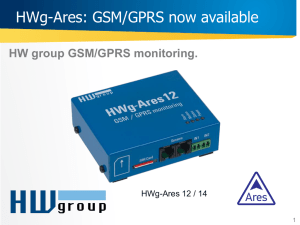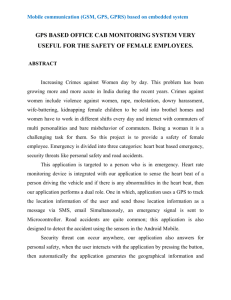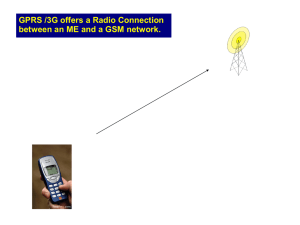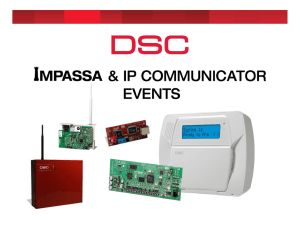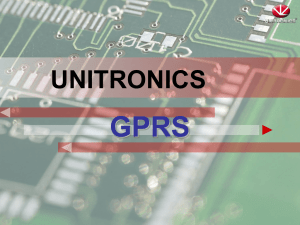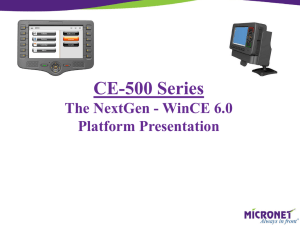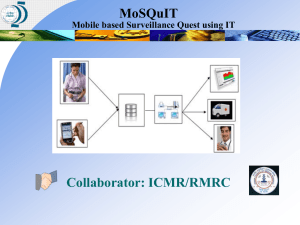DOC - ThinkClock Innovation Labs
advertisement
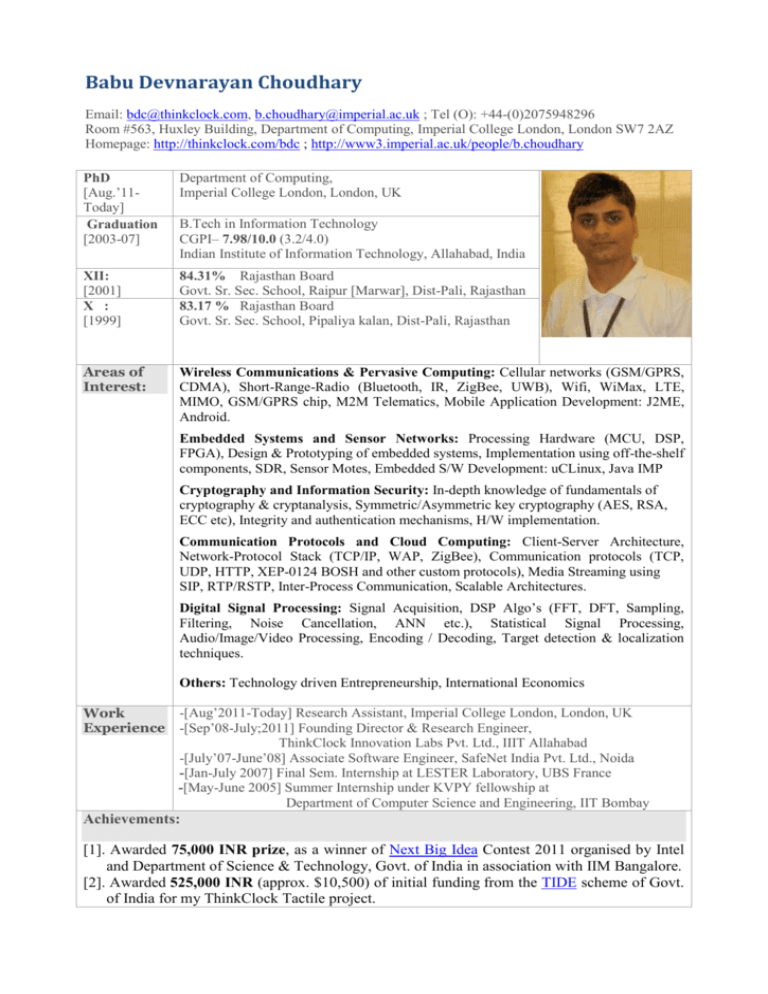
Babu Devnarayan Choudhary Email: bdc@thinkclock.com, b.choudhary@imperial.ac.uk ; Tel (O): +44-(0)2075948296 Room #563, Huxley Building, Department of Computing, Imperial College London, London SW7 2AZ Homepage: http://thinkclock.com/bdc ; http://www3.imperial.ac.uk/people/b.choudhary PhD [Aug.’11Today] Graduation [2003-07] Department of Computing, Imperial College London, London, UK XII: [2001] X : [1999] 84.31% Rajasthan Board Govt. Sr. Sec. School, Raipur [Marwar], Dist-Pali, Rajasthan 83.17 % Rajasthan Board Govt. Sr. Sec. School, Pipaliya kalan, Dist-Pali, Rajasthan Areas of Interest: Wireless Communications & Pervasive Computing: Cellular networks (GSM/GPRS, CDMA), Short-Range-Radio (Bluetooth, IR, ZigBee, UWB), Wifi, WiMax, LTE, MIMO, GSM/GPRS chip, M2M Telematics, Mobile Application Development: J2ME, Android. B.Tech in Information Technology CGPI– 7.98/10.0 (3.2/4.0) Indian Institute of Information Technology, Allahabad, India Embedded Systems and Sensor Networks: Processing Hardware (MCU, DSP, FPGA), Design & Prototyping of embedded systems, Implementation using off-the-shelf components, SDR, Sensor Motes, Embedded S/W Development: uCLinux, Java IMP Cryptography and Information Security: In-depth knowledge of fundamentals of cryptography & cryptanalysis, Symmetric/Asymmetric key cryptography (AES, RSA, ECC etc), Integrity and authentication mechanisms, H/W implementation. Communication Protocols and Cloud Computing: Client-Server Architecture, Network-Protocol Stack (TCP/IP, WAP, ZigBee), Communication protocols (TCP, UDP, HTTP, XEP-0124 BOSH and other custom protocols), Media Streaming using SIP, RTP/RSTP, Inter-Process Communication, Scalable Architectures. Digital Signal Processing: Signal Acquisition, DSP Algo’s (FFT, DFT, Sampling, Filtering, Noise Cancellation, ANN etc.), Statistical Signal Processing, Audio/Image/Video Processing, Encoding / Decoding, Target detection & localization techniques. Others: Technology driven Entrepreneurship, International Economics -[Aug’2011-Today] Research Assistant, Imperial College London, London, UK Work Experience -[Sep’08-July;2011] Founding Director & Research Engineer, ThinkClock Innovation Labs Pvt. Ltd., IIIT Allahabad -[July’07-June’08] Associate Software Engineer, SafeNet India Pvt. Ltd., Noida -[Jan-July 2007] Final Sem. Internship at LESTER Laboratory, UBS France -[May-June 2005] Summer Internship under KVPY fellowship at Department of Computer Science and Engineering, IIT Bombay Achievements: [1]. Awarded 75,000 INR prize, as a winner of Next Big Idea Contest 2011 organised by Intel and Department of Science & Technology, Govt. of India in association with IIM Bangalore. [2]. Awarded 525,000 INR (approx. $10,500) of initial funding from the TIDE scheme of Govt. of India for my ThinkClock Tactile project. [3]. Awarded 100,000 INR prize by Texas Instruments, as a winner in All India DSP design Contest 2006 for project “Collision Avoidance System for Smart Automobiles”. [4]. Awarded French International Scholarship (1000 euro/month plus airfare) from EGIDE for final semester internship at LESTER Lab, UBS France. [5]. Awarded Honorable Mention (including $300 prize and trip sponsorship to the award ceremony in San-Francisco) by 43rd Design Automation Conference ( DAC 2006 ) for paper titled “Phase Delay based Collision Avoidance RADAR for Smart Automobiles”. [6]. Selected by ISRO/ASI as one of 20 semifinalists from across India for International Astronautical Congress (IAC 2006) held at Valencia, Spain. [7]. One of 6-finalists in Idea-to-Implementation 2008 -an All India Business Plan Competition held at IIM Calcutta. [8]. One of 8-finalists in NIRVAAN 2007 -an All India Business Plan Competition held at IIM Lucknow. [9]. KVPY-2004 Fellowship. KVPY - Kishore Vaigyanik Protsahan Yojana, a research program conducted by IISc Bangalore and funded by Department of Science and Technology, Government of India, in which about 20 students are selected from engineering stream every year. [10]. Project INFiANS reached up to semifinal round of worldwide contest Windows Embedded Student Challenge 2006 conducted by Microsoft. [11]. ILTP/MHRD fellowship for working as a project assistant at robotics lab, IIIT Allahabad. [12]. Sun-Tracker design selected for IEEE INDICON-2004 Hardware Design Contest held at IIT Kharagpur. [13]. Secured 17th rank in RPET (Rajasthan Pre-Engineering Test) 2003 in general category [14]. Awarded Rajasthan Gramin Pratibha Vikas Fellowship from class 9th-12th by State Government. Skill-Set: Generic Development: Java: J2SE, Servlet, JSP, J2ME; C, C++, MySQL, SQL Toad, XML, Shell Script, OpenSSL, Asterisk, MATLAB: Simulink, Real-time work shop; MS Visual Studio, Rational rose (UML), Google Maps API: static/dynamic Java / J2ME Development Tools : Eclipse J2SE/J2EE, EclipseME, Mobile Tools for Java (MJT), JUnit , J2MEUnit, J2ME Sun Wireless Toolkit, Apache Tomcat, JDBC, Ant, Sun JavaMail API, Sun JavaBeans Activation Framework, Java SMS Lib Embedded Development Tools : Siemens XT65 GPS/GPRS module with Java IMP, Texas Instruments: DSP C6713, Code Composers Studio, Altera: Startix II FPGA, Nios II IDE, Quartus II, SOPC builder, Microchip PIC MCU Development kit with C18 compiler, Communication modules : ZigBee, Embedded Ethernet, SIMCOM 508 GSM/GPRS-GPS module Soft Skills: Good at presenting, communicating and coordinating effectively Projects: (1). Remote Energy Metering System [ Sept’09-today, ThinkClock Innovation Labs Pvt. Ltd., IIIT Allahabad] Role: Lead Developer Skills: MCU: Microchip PIC8F8722, GSM/GPRS: SIMCOM 300 module, ZigBee: Microchip MRF24J40MA, Metering IC MCP3909, Microchip IDE and C18 Compiler Project involves analog instrumentation of current & voltage sensing with temper protection mechanism and calculation of energy consumption in the load using MCU. Data from sensors of each phase are multiplexed into one SPI port of MCU. The controller MCU is interfaced with GSM/GPRS module through UART port and ZigBee & ethernet module through SPI ports. The energy consumption data is communicated to a central server (listening TCP, UDP or HTTP) periodically or on-demand through GSM/GPRS or pluggable ethernet in combination with ZigBee wireless mess network. A mechanism for two way communication with the meter is being developed using BOSH/SIP protocols. (2). SIP Mediator Client for routing audio/video from IP Camera to Asterisk PBX Server [ Sept’09-today, ThinkClock Innovation Labs Pvt. Ltd., IIIT Allahabad] Role: Lead Developer Skills: Linux, Asterisk PBX Server, SIP, codec conversion, Ekiga SIP client, TCP/IP, UDP, HTTP Project involves routing of audio/video data from a IP Camera (acting as a TCP/UDP/HTTP server) to an Asterisk PBX Server (Open source Telephony server compatible with SIP clients) by developing a Mediator SIP client on linux. The implementation is accomplished through inter-process communication (through shared memory access & semaphores) where one process retrieves audio/video data from IPCAM writing into a shared memory and other process fetching that data from shared memory to Ekiga SIP client (which routes to Asterisk). It also involves conversion of audio/video codecs because of compatibility reasons. (3). Automotive Telematics System for Remote Tracking & Monitoring [ Sept’08-Sept’09, ThinkClock Innovation Labs Pvt. Ltd., IIIT Allahabad] Role: Lead Developer Skills: Java: J2SE, Servlet, JSP, J2ME, MySQL, SQL Toad, XML, Google Maps API: static/dynamic, Eclipse J2SE/J2EE, EclipseME, Mobile Tools for Java (MJT), JUnit , J2MEUnit, Sun Wireless Toolkit, Apache Tomcat, JDBC, Java SMS Lib Project involves development of an Integrated Automotive Telematics System for vehicles to provide location based services like remote tracking & voice navigation with vehicle safety features using GPS, GSM/GPRS, GIS Technologies. The complete system is broadly modularized into following parts. (1). Automotive Telematics Unit: This H/W device (based on Siemens XT65 GPS/GPRS module with Java IMP profile) is having following key components and running our embedded S/W module: (a). Location sensing module: GPS using NMEA protocol (b). GSM/GPRS module: for communication with server running Telematics Engine (c). Controller: Microchip PIC18F8722 (2). Telematics Engine: This is a S/W component running on server connected to internet and responsible for receiving, parsing, interpreting the data using GIS coming from Automotive Telematics Unit via cellular network. It supports TCP, UDP, HTTP, SMTP and SMS protocols for receiving data packets. (3). User Presentation Module: This is client-side S/W module using which user can connect to the Telematics Engine and locate & track vehicle on GIS map with complete history. It is a Web-based Tracking client for PC users: a servlet fetching Google Maps using Javascript. (4). J2ME based mobile application suite for location based services [Sept’08-Sept’09, ThinkClock Innovation Labs Pvt. Ltd., IIIT Allahabad] Role: Lead Developer Skills: EclipseJ2ME, J2ME: CLDC/MIDP, J2EE-Servlet, JSP; Apache Tomcat, MySQL, Google Maps static API, GSM/GPRS/SMS It involves development of the following mobile applications for location based services (a). J2me based Remote Asset Tracking using SMS/GPRS: for tracking vehicles remotely in real-time over Google/Yahoo/OpenStreet Maps (b). J2ME GPS Navigation Application: using Bluetooth GPS or GPS handset user can navigate himself on map (c). Mobile GPS Tracking Application using SMS/GPRS: this applications sends GPS data to a server by GPRS or to a other mobile phone by SMS for tracking (d). J2ME Multimedia Sharing Application (Images, Audio, Video): user can upload location tagged Images/Audio/Video to a server by GPRS and other users can see them on mobile using same Midlet. (5). Software License Management System [ july’07-June’08 at SafeNet India Pvt. Ltd., Noida, India] Role: Developer Skills: C, C++, SQL, OpenSSL, Cryptographic Algo’s (AES, RSA, ECC, SHA-1, SHA-2, HMAC), Design Documentation (FDD) Project involves development of Software license management system targeted for software vendors to enable them to protect their applications using our client API and license management server. I am responsible for design and development of Crypto-Layer to secure the communication between client and server in this project. During this project I explored and used various symmetric and asymmetric crypto-algorithms (AES, ECC, RSA, SHA, HMAC etc) and crypto tools like OpenSSL. (6). Hardware Implementation of ECC and RSA algorithms on FPGA using Nios II softprocessor [During final semester internship jan-july’07 at LESTER Lab, UBS France] Role: Lead Developer Skills: C++, MS Visual studio, Nios IDE, SOPC Builder, ECC, RSA, Sha-1, Sha-2 It involves hardware implementation of ECC-the next generation crypto-system along with RSA to speed-up and enhance the security of public key crypto-systems using Altera FPGA and Nios II softprocessor. Programming was done in C++ and then code was built for target hardware (Altera FPGA) using Altera IDE. During this project I developed new side-channel resistant ECC point multiplication algo (filed for patent). Computationally intensive part of the code (ECC point multiplication and addition) was implemented in hardware using VHDL. (7). Collision Avoidance System for Smart Automobiles [During 7th semester July-Dec'06, Winner of Texas Instruments DSP design Contest 2006] Guide: Prof. M. Radhakrishna, IIITA, Team: 2 members, Role: Project leader Skills: MATLAB: simulink, real-time workshop, TI DSP C6713, Atmel MCU Atmega 169 System assists driver to have critical decisions through audio alerts during driving to avoid accidents. It provides information about distance and speed of vehicles in vicinity and also alerts when sees road hurdles hence making driving easy in traffic congestion and bad weather conditions. System can also function as black-box for accident analysis. System was implemented using TI DSP C6713, AVR Butterfly kit having ATmega 169 MCU and MATLAB DSP support. (8). Multiple Fundamental Frequency Estimation [During 7th semester July'06-Dec'06, as an assigned work] Guide: Prof. Michael Jordan, University of California at Berkeley, US, Team: alone Skills: MATLAB: simulink, real-time workshop, audio signal processing Project involves implementation of a state-of-art method for estimating the fundamental frequencies (F0) of several concurrent musical sounds using perceptually motivated method. The method consists of a computational model of the human auditory periphery, followed by a novel periodicity analysis mechanism. Estimation of multiple fundamental frequencies is achieved by canceling each detected sound from the mixture and by repeating the estimation for the residual. (9). INFiANS - Intelligent Noise Filtering using Adaptive Noise Cancellation, Neural Networks and Blind Source Separation [During 6th semester Jan'06-July'06, as a course Project, reached up to semifinal round of worldwide contest Windows Embedded Student Challenge 2006] Guide: Prof. M. Radhakrishna, IIITA, Team: 4 members, Role: Project leader Skills: MATLAB: simulink, real-time workshop, audio signal processing This Project employs a mobile based solution for noise pollution control. It involves intelligent noise filtering techniques ANC, ANN and BSS to filter out unwanted sound signals and enables user… To listen only sounds of interest ignoring crap sounds. To be in complete peace in a noisy environment. To have easy mobile conversation in crowded or cocktail party environment so that two side talkers will listen only each other’s voice irrespective of their environments. (10). A Kernel Level Overload Detection Mechanism for TCP Servers [During May-June ’05 at CSE Department, IIT Bombay in KVPY summer program] Guide: Prof. Varsha Apte, CSE, IITB, Team: alone Skills: C, Linux (Debian/Suse), Linux Kernel, TCP/IP Layer, TCP/IP, UDP, HTTP This project employs a kernel level overload detection mechanism for Web servers. Approach is based on SYN and Accept queues, which a TCP server maintains at TCP layer during three-way handshake. It also predicts the bottleneck resource (server machine or network). It was accomplished by modifying TCP/IP layer of the kernel code. (11). Sun Tracking System for maximizing the effectiveness of solar panel [During 2nd semester Jan ’04 – June ’04, selected for IEEE INDICON-2004 Hardware Design Contest] It is an electromechanical system which senses the direction of the Sun using 4-LDR sensors mounted on a cuboid and operates a DC motor to reorient the solar panel to keep it facing always towards Sun. Personal Information Name: Mr. Babu Devnarayan Choudhary Father’s Name: Shri Kana Ram Saincha Date of Birth: Aug.20, 1985 Nationality: Indian Languages Known: English, Hindi, Rajasthani Hobbies: Solving Puzzles, Exploring new ideas, Meditation for stress management. I hereby certify that all the information provided above is true to the best of my knowledge. -Babu Devnarayan Choudhary References Prof. M. Radhakrishna Prof. R.C. Tripathi Prof. Guy Gogniat Head of the Department, Department of Electronics & Communication, IIIT Allahabad, India-211012 Dean, R&D, IIIT Allahabad, India-211012 Associate Professor, Lab-STICC Laboratory, Université de Bretagne Sud, Centre de recherche - BP 92116 56321 LORIENT Cedex, FRANCE Email: mkrishna@iiita.ac.in Ex. Sr. Director, R&D in IT Group, DIT, Min of Comm‟ n & IT, (MCIT) Govt of India, New Delhi Email: guy.gogniat@univ-ubs.fr Email: rctripathi@iiita.ac.in

